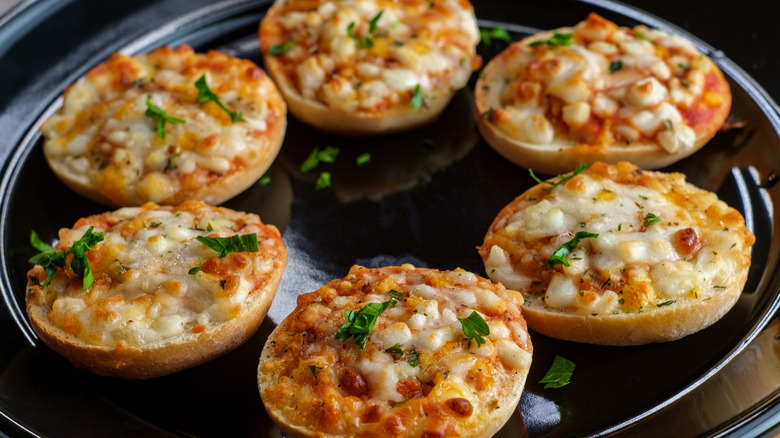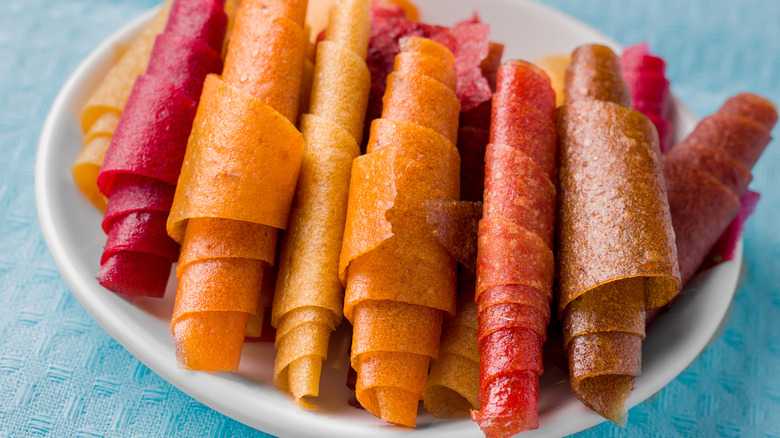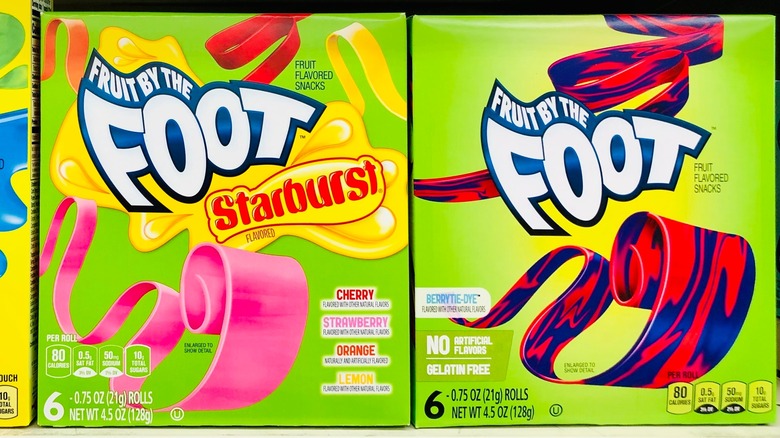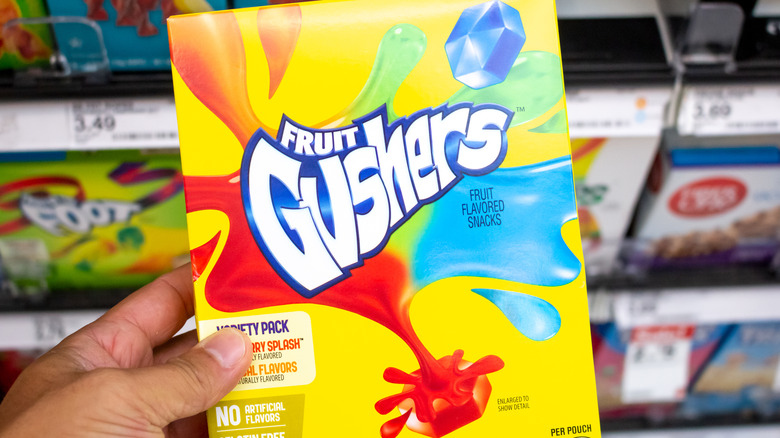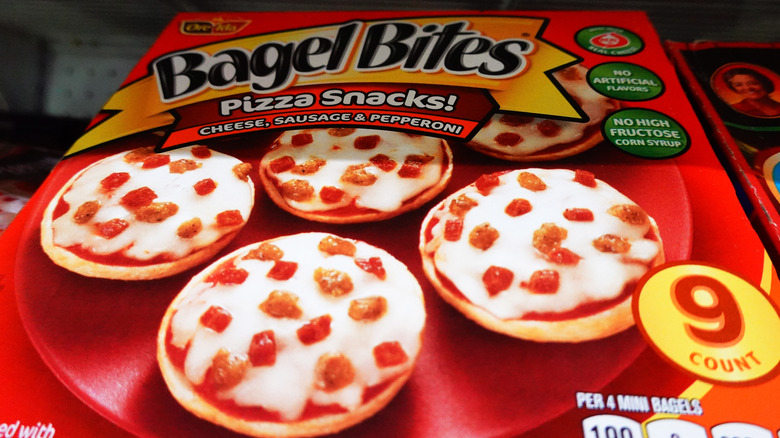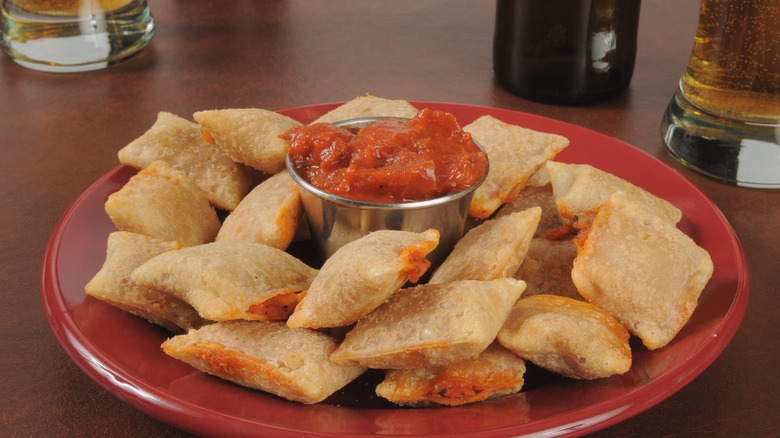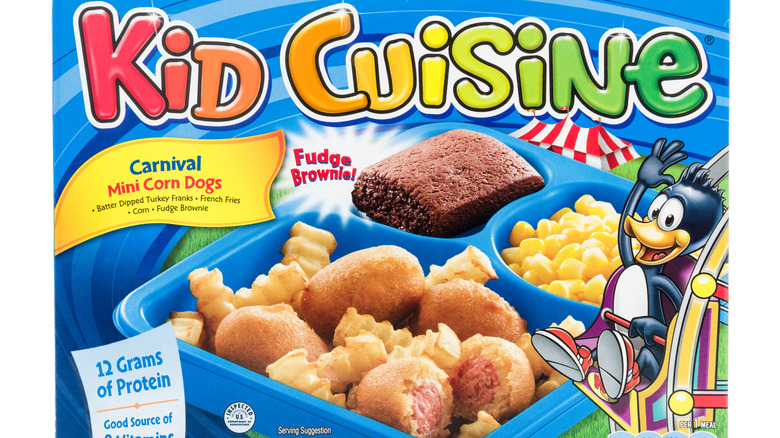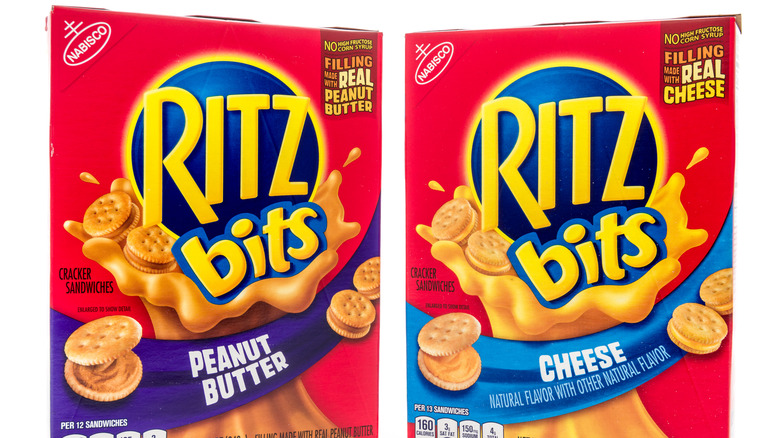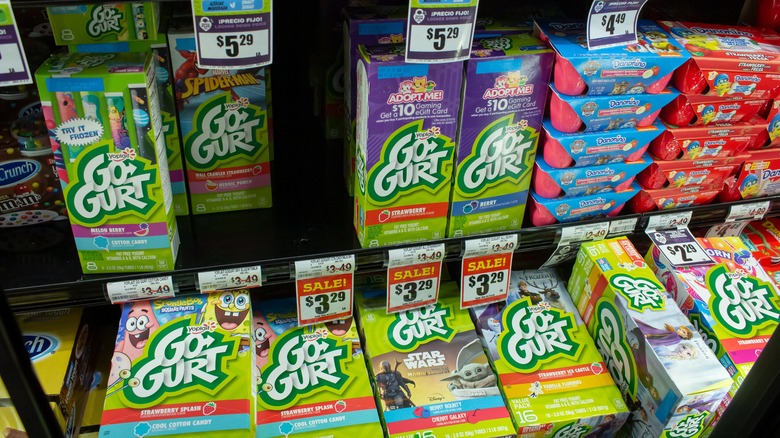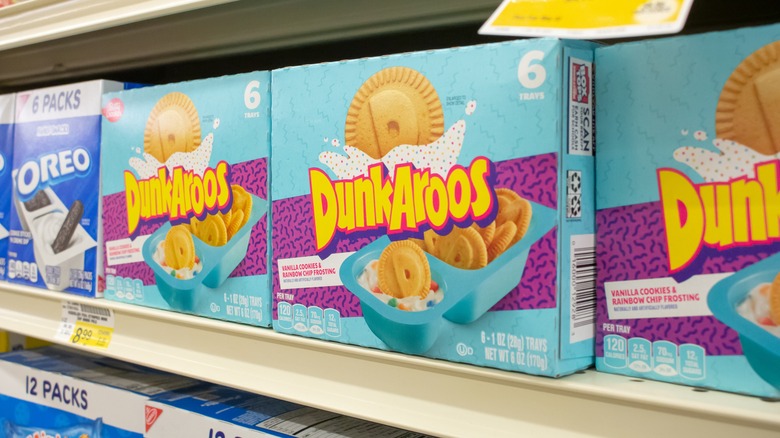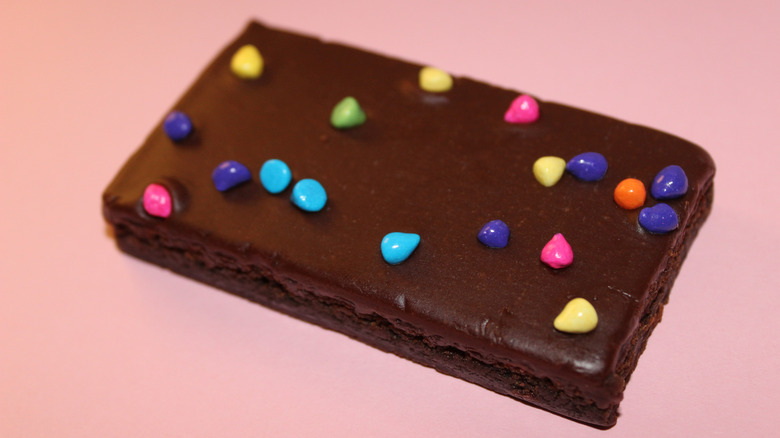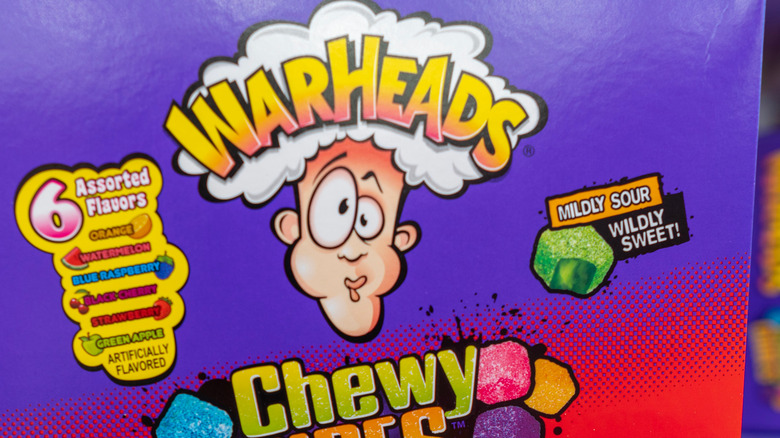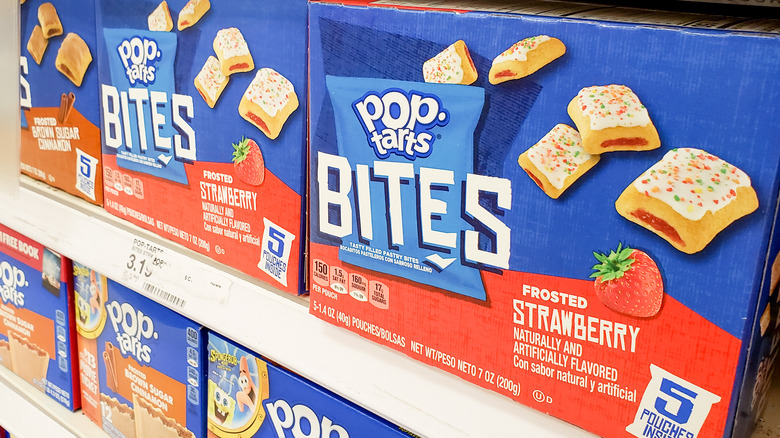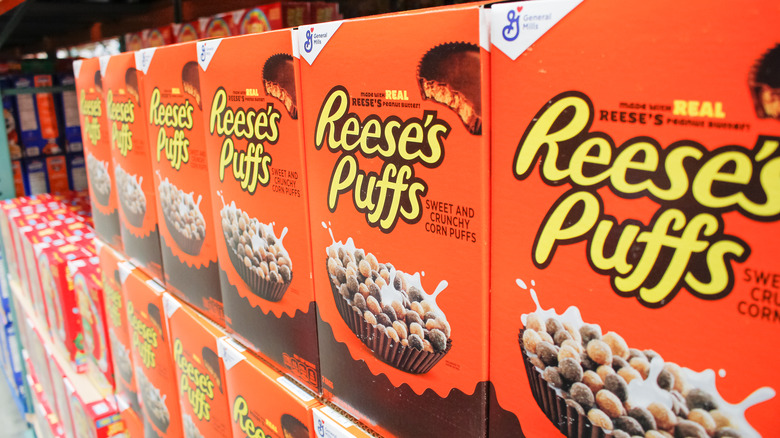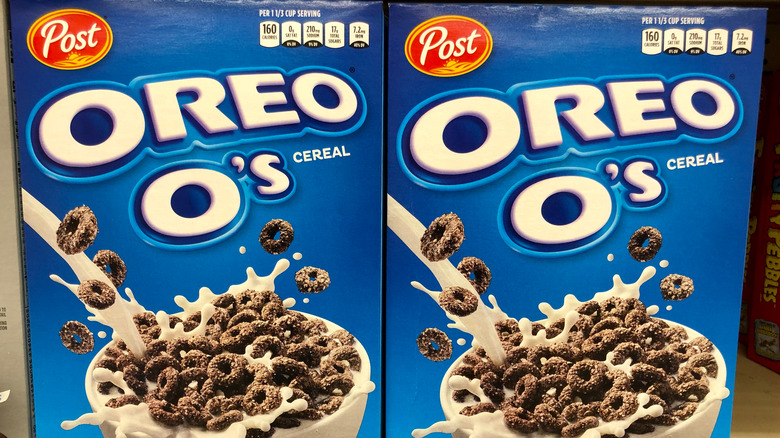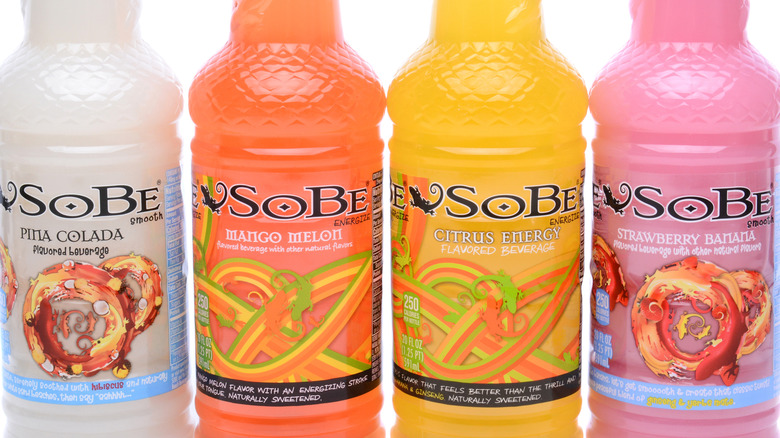90s Snack Foods You Can Surprisingly Still Eat Now
Between reality TV's takeover of the airwaves, the rise of the internet, and LFO's "Summer Girls," you could be forgiven for believing that the Clinton years were a collective fever dream, only rivaled in their madness by every year that followed. But the so-called "End of History" was all too real, and its unique sensuous experiences are forever seared into the minds of those walking relics who doodled with Kid Pix on their Bondi Blue iMacs known as "90s kids." From the screech of a Bop It calling out a failed command to the kaleidoscopic colors of your neighborhood Incredible Universe, the 1990s were an age where subtlety was for lamewads.
Naturally, the wacky sensibilities of the 90s extended to food. The odder fare, like Canadian juice blends with suspended gelatin balls, may have had ignominious and quick demises, but plenty of the things millennials grew up shoveling into their mouths became nostalgia-adorned favorites, either reappearing after decades in the limbo of discontinuation or cementing themselves into old standbys on supermarket shelves that not even the post-"Super Size Me" concern for children's nutrition could dislodge. From acidic hard candies evoking chemical warfare to cookies reformatted as a breakfast cereal, these are the sweets, treats, and quick bites that an All-Star like you can still smash in your mouth today.
Fruit Roll-Ups
The 90s saw the explosion of gummy fruit snacks from General Mills that boasted just enough natural fruit ingredients to avoid qualifying as purely candy, allowing them to position themselves as products that both appealed to a kid's desire for bright colors and syrupy sweetness, and a parents' capacity to relent in the face of "well, at least they're kind of eating fruit." While the more "natural" alternative we know as "fruit leather" had already been around for some time, Fruit Roll-Ups blew the doors open for a lot of the pectin-based fruit snacks we remember from the 90's.
Even though they were in R&D as far back as the 1970s, General Mills itself admits that the 90s were when Fruit Roll-Ups found their market and exploded in popularity. After shifting the treats to their Betty Crocker brand, and riding off the mascot marketing boom, General Mills debuted the wizard character "Rolupo" in 1990 to brand and promote the sheets of sticky fruit-flavored gel. By 1991 the character was retired and Nickelodeon quickly entered into a licensing deal with General Mills, introducing versions pre-cut into the shapes of characters from the cable network's lineup of original animated shows. The die was cast, and Fruit Roll-Ups, despite their controversy over "candifying" what was originally mashed, dried fruit, have stayed on store shelves ever since.
Fruit by the Foot
Hot off the heels of the Fruit Roll-Ups' boom, General Mills stretched its snack to a three-foot-long strip and released it under its own name in 1991. Like its squarer cousin, Fruit by the Foot hasn't once been discontinued since its first iteration. Even the Berry Tie-Dye flavor is still around, with its swirling colors introduced to capitalize on the 90s continuation of the 80s revival of the 60s counterculture fashion statement.
The popularity of the almost-meter-long variant of GM's original fruit snack made confusion over the name fairly frequent. In the 90s, the thinner, longer, more rolled-up offering was frequently called "fruit roll-ups" by the average consumer, ignoring the distinction between the sheet and strip form factors. This quibble over names seems to have extended even into the social media age, forcing the brand's own Twitter account to clarify: "All Fruit by the Foot are fruit roll ups, but not all Fruit Roll Ups are Fruit by the Foot." The favoring of the longer version of the Fruit Roll-Up mirrors a recent phenomenon in the Japanese market, with the 2017 "Long, Long Man" ads for Sakeru fruit gummies going viral and sweeping global advertising awards. Seems General Mills hit on a global truth: People like their fruit — well, by the foot.
Fruit Gushers
Goooze. Floam. Gak. If these words mean nothing to you, you were likely not a 90s kid or your parents really did not want you playing with anything that would absolutely ruin their carpet. What these 90s-era Nickelodeon-branded gunky toys demonstrate is that kids love slime, and Gushers pack a tart, syrupy jet of fruity goo in every bite. While that may explain their staying power, their aggressive advertising no doubt immediately earned them a captivated consumer base.
And what advertising it was. The novelty of biting into a fruit gummy and getting a burst of saccharine effluvium played no part in the original Gushers ad campaign. The pitch to kids was ecstatic body horror, showing hip young actors hanging out, popping Gushers, and immediately being transformed into grotesque fruit-headed creatures while having an absolutely tubular time. If Fruit Roll-Ups had their pretensions of possibly being healthy with their similarities to traditional fruit leather, Gushers threw out all concerns of being marketable to health-conscious parents with their bonkers commercials. However, when the concern over kids' consumption of artificial sweeteners and colors grew too strong in the 2010s, General Mills relented. Since 2017, the company has reportedly removed all artificial colors and flavors from Fruit Roll-Ups, Fruit by the Foot, and Gushers.
Bagel Bites
The oddly-musical Bagel Bites were created in 1985 by a pair of enterprising Floridians, then sold to a Canadian company, which was then acquired by Kraft Heinz in 1991 and sold under its Ore-Ida brand, of frozen French fry fame. Today, the mini pizzas' marketing jingle, cribbed from the 1957 pop single "Sugartime," still echoes through the minds of kids who were watching Saturday morning cartoons between the years of the Manuel Noriega trial and the release of "Pokémon: The First Movie." Jimmy Fallon and Meat Loaf even paid tribute when they literally sang the Bagel Bite's praises on air.
The 90s saw the world discovering just how much pizza could motivate children, with Pizza Hut's famed "Book-It" reading enticement program — offering personal pizzas in exchange for books read – entering its fifth year in 1990. The thickness of a miniaturized half-bagel gave these tiny pizzas the foundation they needed to stay intact and be easily eaten with one hand. They were quick, portable, and exciting to kids who saw the indulgence of a pizza shrunk down into a convenience, complete with bacon bits-sized chunks of minced pepperoni.
Bagel Bites remain in grocery store freezers to this day. However, 2022 saw their discontinuation in Canada.
Totino's Pizza Rolls
Totino's Pizza Rolls are the result of decades of corporate merging and acquisition. While Rose Totino was building the take-home frozen pizza side of her Minneapolis pizzeria business, Jeno Paulucci was building a frozen food empire, and combining his frozen Chinese egg roll casings with pizza filling. Pillsbury acquired the Totino's frozen food company in 1975, then Paulucci's in 1985. A few years later, and the Totino's name adorned boxes of Paulucci-style pizza rolls.
Totino's tries to market Pizza Rolls as a party food for fun social gatherings, but the cultural footprint of Totino's Pizza Rolls among millennials is inexplicably steeped in dark, ironic alt-comedy, always associating the snacks with the strange and idiosyncratic. Gonzo sketch comedians Tim Heidecker and Eric Wareheim produced a Totino's ad campaign in 2014, replete with absurdist digressions and discordant non-slogans like "I'm Totino the Pizza Boy!" Meanwhile, the comedic movie reviewers behind Red Letter Media gave their shut-in film obsessive character Harry S. Plinkett an obsession with the snacks. Saturday Night Live made a whole series of parody Totino's ads that tied Pizza Rolls to everything from cosmic horror, to feminine existential dread, to suppressed Sapphic sensuality. 90s kids may have loved Pizza Rolls, but as adults, they know there's just something off about them.
Kid Cuisine
The TV dinner craze has long since crested and crashed, but ready-made frozen meals have never completely disappeared. As long as the 40-hour work week persists, people will find themselves unable to cook from scratch at some point. Kid Cuisine wasn't the first attempt to produce a frozen dinner for children: the 70s saw the brief tenure of Libbyland Dinners, with a similar assortment of entrees to Kid Cuisine, such as hot dogs and hamburgers. While the typical Kid Cuisine packaging shows the brand's long-standing mascot, penguin KC, on some adventure or engaged in any number of fun sports, the branding hasn't changed the fact that giving your child a dress rehearsal for eating like a depressed adult fails to appeal to most parents, especially when child nutrition watchdogs are sounding the alarm over the volume of fat and salt.
Kid Cuisine may have a 30-plus-year track record, but their product line has atrophied to three choices of meal spread, all centered around some kind of breaded processed meat, with corn as their only vegetable on offer. It's anyone's guess how much longer nostalgia or convenience as selling points will keep Kid Cuisine around.
Ritz Bits
What if an Oreo, but savory? In 1989, Nabisco set about to answer this question and ended up with the two flagship flavors of their miniaturized cracker sandwiches: peanut butter, and cheese. Other varieties have come and gone and come again since, including the death and brief rebirth of a S'mores version with a combination of quasi-Nutella and marshmallow creme between the two shrunk-down crackers.
We at Mashed have strong opinions on crackers, but even we can't deny the lasting appeal of Ritz Bits. Whether you grew up favoring the "peanut butter" or "cheese" filling — with the package promising that they were made with the real thing! — you likely remember the stop-motion animated commercials featuring swarms of mischievous crackers going to town on either a jar of peanut butter, or an entire planet of "Cheez" before combining in some kind of cracker fusion dance. The miniature cracker sandwiches are still around, and are still sold in small, individual mylar bags or plastic cups, holding what would be a heaping handful for your average eight-year-old.
Go-Gurt
Before the rise of Roblox and the age of your average suburbanite buying cars with four-foot-high grilles and deadly front blind spots that could turn your average ten-year-old into mulch, kids used to play outside in the streets of their subdivisions. 90s parents occasionally needed to fight their kids' urge to rush out the door just long enough to get a healthy-enough snack down their gullets so they wouldn't try to raid the fridge later. Thus Go-Gurt was born. Kids of the Clinton administration may not have been ready for kefir, but they definitely saw the appeal of yogurt that could be consumed single-handedly.
General Mills, parent company of Yoplait, introduced the Otter Pop-style slurpable tubes of low-fat yogurt in 1998, and still maintains pride in the brand. From the mad-eyed ramen-haired skater kid mascot that graced the first boxes of Go-Gurt, to the contemporary licensing deals with kid-favorite intellectual properties like Spongebob and Star Wars, Go-Gurt's been a precision-tooled product for kids since its very inception. Contemporary kids may not be running out the door to go skate, and may be spending more time than ever indoors, but convenience is timeless.
Dunkaroos
It was the summer of 2020. The Covid-19 pandemic was surging while plunging the world into economic devastation. The George Floyd uprisings shook cities large and small across the United States. Dunkaroos returned to US store shelves. Never before had the urge to psychically regress to childhood innocence been so strong for millennials, nor had the task been ever so easy. General Mills themselves put out the clarion call directly to 90s kids in the company's official blog. When the frosting-scooping cookies reemerged they came from having spent the past eight years exiled to Canada, during which GM held a promotional campaign literally encouraging smuggling.
The cheeky faux-criminal solicitation campaign reflected a change in advertising regulations in Canada. With Dunkaroos being too sugar-laden for the Canadian authorities to allow child-centric advertising, GM pivoted to seizing on the repressed nostalgia of American adults by calling for relief packages of the 90s mid-day desert to cross the border. Since the 2020 relaunch, smuggling has become unnecessary, and GM has expanded the line with a relaunched chocolate frosting version. The cartoon kangaroo mascots may not have been revived, but at least now no US citizen has to learn how to pronounce "Rien à déclarer" to a suspicious Québécois customs agent for the sake of cookies.
Little Debbie's Cosmic Brownies
McKee Foods launched the Little Debbie's Cosmic Brownie in 1999, and the company is absolutely transparent about its inspiration: cosmic bowling. The Brunswick Corporation, a sporting goods empire with a focus in boating and RVs, had been producing bowling products since the 1900s, and with a new millennium fast approaching, almost everything that could be branded with the images and signifiers of expansive new futuristic horizons got some kind of sci-fi makeover. Bowling, the sport most associated with middle-aged men didn't escape this phenomenon, and the introductions of black lights and fluorescent colors to Brunswick's bowling lanes sparked the trend of turning bowling alleys into sci-fi psychedelic spaces that appealed to younger crowds. The aesthetic trend's success outpaced Brunswick's ability to react, and McKee Foods introduced their "cosmic-ized" brownies a full four years before Brunswick filed their trademark for cosmic bowling.
The carnival-colored candy-coated chocolate chips atop Little Debbie's Cosmic Brownies have nothing to do with space, and even less to do with black light bowling, but the aesthetic has stuck and maintained itself for almost thirty years now. Even though the intervening years have seen people embrace rose gold phones and "pale blogs" on Tumblr, McKee Foods still declares that the loudly-colored Cosmic Brownie will "never go out of style." In fact, it's now even back in cereal form.
Warheads
A candy with enough natural acid in it to chemically burn the inside of your mouth in large quantities. Impact Confections built it, and 90s kids came in droves. To this day, Warheads are just as much a fun treat as a rite of passage. Brave the few seconds of singing acidic sourness and break through to the other side, your saliva dissolving the acidic coating before it can do the same to you, and feel the relief of the candy's pleasantly-sweet core. In ancient times we sent our children into the wilderness to build fires and come back inducted as adults. Since the candy came to the US in 1993, kids have tested each other's mettle with Warheads.
The mixture of ascorbic, citric, lactic, and malic acids giving Warheads their unrivaled sourness is within FDA limits but in the years since their debut, Impact Confections has had to introduce warnings to those with sensitive mouths against eating too many in a brief time frame. Warheads play off children's desire to push the boundaries of safety, but they came about before the age of MTV's "Jackass" and viral video challenges. For better or worse, we now know just how many Warheads it takes to make your mouth bleed.
Pop-Tarts Bites
Originally launched in 1994, the first wave of Pop-Tarts Bites lasted only a year before being discontinued. 2018 however, saw their sudden return to grocery stores. These tiny, frosted breakfast ravioli have been maintaining their supply now longer than they ever did during the initial 90s launch, and come in six recreations of their full-sized counterparts' flavors.
The brief tenure of Pop-Tarts Bites in '94 may leave 90s kids thinking they merely dreamed of them as kids, but their relaunch was overtly planned to leverage some degree of 90s nostalgia, to hear the brand's own marketing directors tell it. With the new wave having the kind of longevity that the 90s release could only dream of it's more likely than not that come 2043, Pop-Tarts Bites will be a more precious childhood throwback for zoomers than they ever were for millennials. Food is often a lightning rod for nostalgia, but the realities of marketing, branding, and re-branding have made nostalgic attachments more fluid and shifting than ever.
Reese's Puffs
In 1981, Hershey's advertised their Reese's peanut butter cups with the famous "you got your peanut butter in my chocolate" ad. In 1994, a co-branding initiative got Hershey's in our General Mills. Reese's Puffs cereal was reportedly General Mills' first licensed product since an E.T.-branded cereal introduced a decade prior. The association with the Reese's Pieces-loving alien was more than a little prophetic, with the E.T. cereal being chocolate and peanut butter-flavored, making a move from co-branding with the movie character to co-branding with the candy itself a deft maneuver in cutting out the middle man.
2015 saw the phasing out of artificial flavors and colors from Reese's Puffs alongside General Mills' other cereals. Since then, new shapes and inscrutable metaverse promotions have followed in the cereal's wake, but its place on store shelves has been stable. Kids who grew up with E.T. on the theater screen, VHS, DVD, or streaming have all comprised a steady consumer base for Reese's Puffs.
Oreo-O's
Not to be outdone by General Mills, Post licensed Nabisco's famed sandwich cookies in 1998. But after nine years of presumably steady sales, in the wake of Kraft Foods selling its entire Post subsidiary, the chocolate cookie-flavored rings with a speckled cream coating disappeared everywhere except South Korea. For ten long years, between 2007 and 2017, licensing loopholes left the Korean company Dongsuh Foods the only manufacturer still putting out the product, while Post acquired the taste-alike Malt-O-Meals Cookies & Cream cereal.
When Oreo O's relaunched stateside in 2017, however, the differences between its original form and its reboot were easily detectable by comparison to the Korean version. Marshmallow bits were out, fans found the flavor wanting, and the shade-sporting humanoid glob of cream with quintessentially-90s 'tude was gone as a mascot. Fan reaction was split, with some suggesting that the new US Oreo O's were merely Malt-O-Meals' cereal in different packaging. If you were an Oreo O's diehard in the late 90s, your best bet to recapture that flavor may sadly still be to hop on a train to Busan.
SoBe
The milky, neon-colored liquid. The branding allusions to beach and extreme sports culture. The sheer 'TUDE dripping off that aggressively-sneering cartoon lizard. SoBe was pure 90s. Launching in 1995 with a ginseng and guarana-steeped tea that foretold the coming energy drink craze, SoBe was bought by Pepsi in 2000. The soft drink giant has kept the characteristic label typeface, the lizard logo, and the core flavors in stock, but the list of discontinued SoBe varieties outnumbers the current lineup of flavors about twofold. Availability in general has also dwindled, causing fans frequently asking the internet if the line has been discontinued entirely. It may take some searching, but odds are good that at least one grocery store near you has a handful of the surviving SoBe flavors in stock.
The soft drink landscape has experienced titanic shifts since SoBe first launched, so the modest footprint the brand still has is fairly impressive. Traditional sodas aren't going anywhere, while energy drinks are closest runners-up in popularity. Opaque juice-flavored blends with herbal supplements in place of high-octane doses of caffeine are a niche product, and the kids who drank SoBe in the 90s are now watching their sugar intake. Maybe SoBe should get into the seltzer game?
